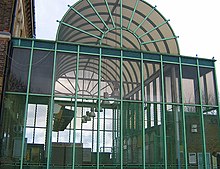Float glass

Float glass is a sheet of glass made by melting glass and spreading it on molten metal that has a low melting point, such as tin,[1] or lead.[2] In this way, we get a very flat and evenly thick surface.[3] Making float glass like that, is also known as the Pilkington process.[4] It was given this name, because the glass-making company Pilkington was the first to use this way of making glass in the 1950s, at their factory in St Helens, Merseyside, England.[5]
Modern windows are usually made from float glass.[6] Some types of glass used for screens are also made in the same way as float glass.
References[change | change source]
- ↑ Richet, Pascal (2021-02-05). Encyclopedia of Glass Science, Technology, History, and Culture. John Wiley & Sons. pp. 73–74. ISBN 978-1-118-79939-0.
- ↑ Binggeli, Corky (7 October 2013). Materials for interior environments. Wiley. p. 86. ISBN 978-1-118-30635-2. OCLC 819741821. 819741821.
- ↑ Groover, Mikell P. (2021). Fundamentals of Modern Manufacturing: Materials, Processes, and Systems. John Wiley & Sons. p. 207. ISBN 978-1-119-70642-7.
- ↑ Baker, Ian (2018-06-21). Fifty Materials That Make the World. Springer. p. 66. ISBN 978-3-319-78766-4.
- ↑ "The Story of Pilkington UK". www.pilkington.com. Retrieved 2023-04-09.
- ↑ Shackelford, James F. (2005). Introduction to Materials Science for Engineers. Pearson Education. Prentice Hall. p. 237. ISBN 978-0-13-142486-9.
Other websites[change | change source]
- Float Glass Manufacture Process from the Glass Association of North America
